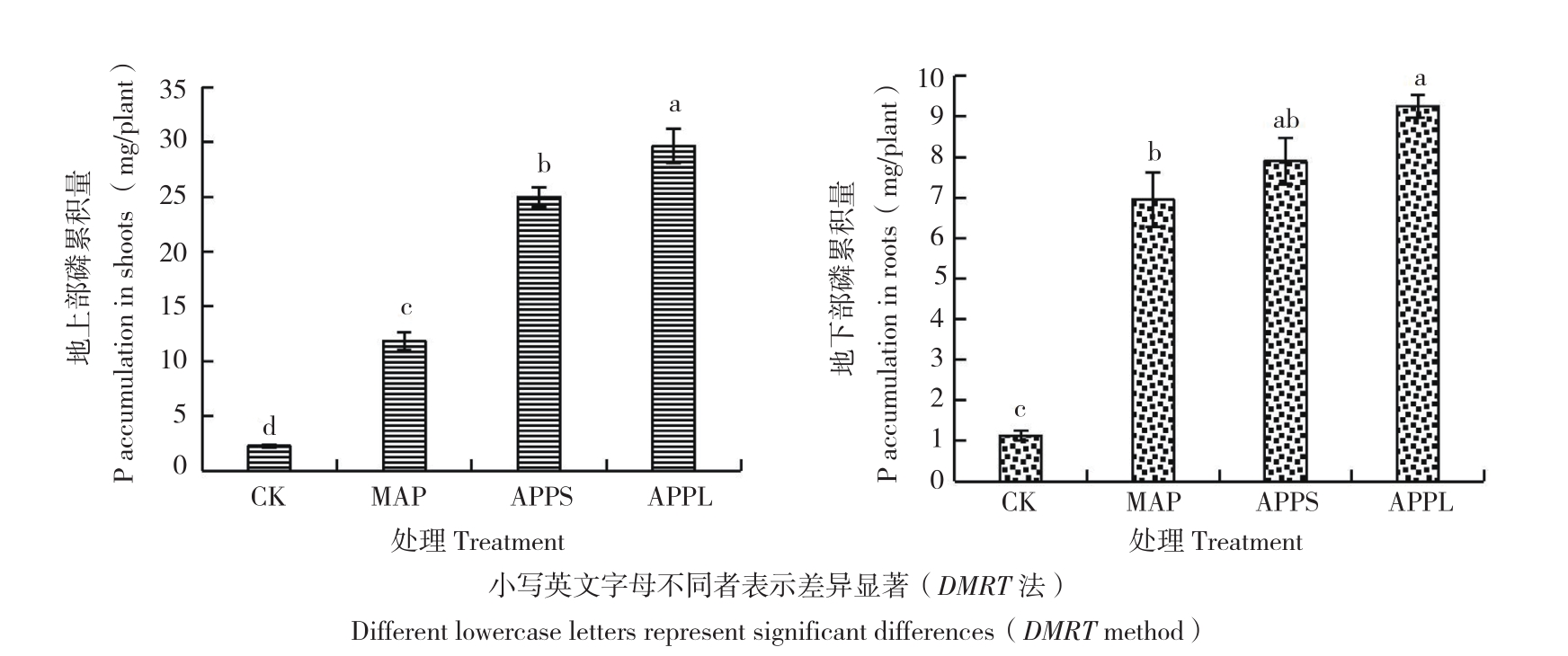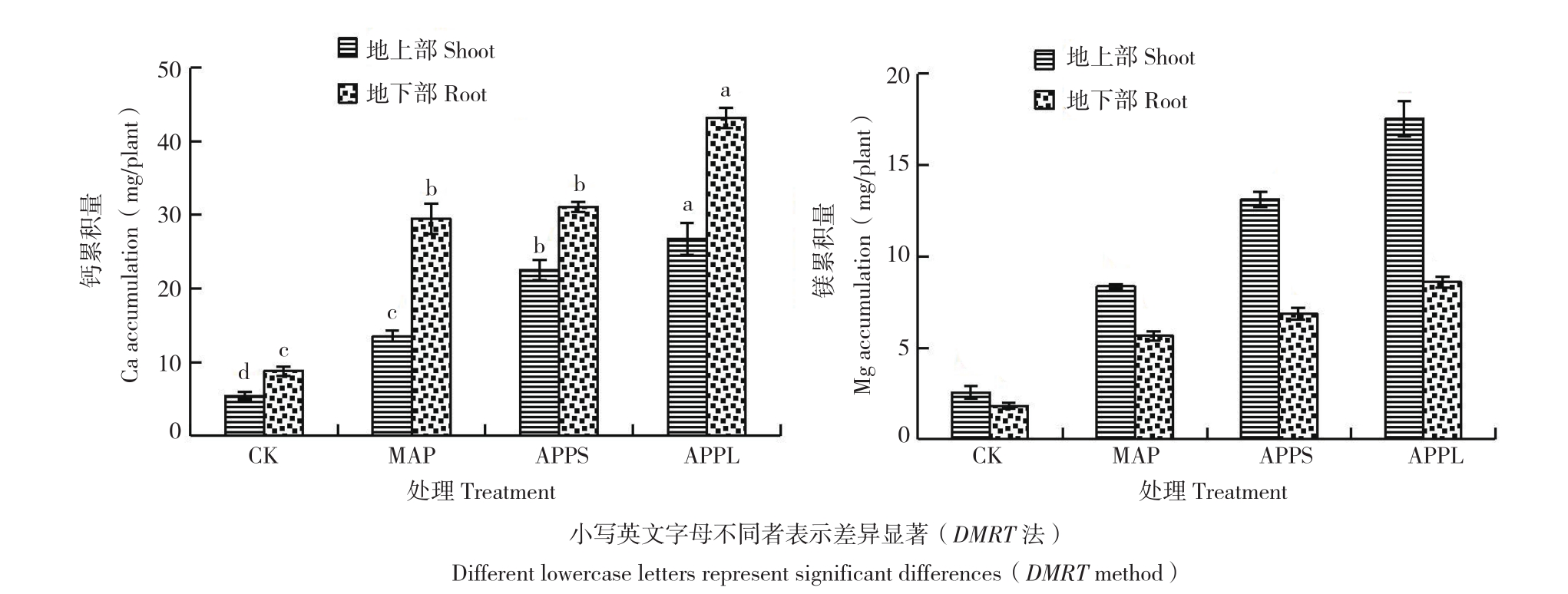【研究意义】聚磷酸铵,又称多聚磷酸铵或缩聚磷酸铵(简称APP) ,分子结构通式为(NH4)n+2PnO3n+1,系无分支的长链聚合物,其聚合度越高水溶性越小,反之则水溶性越大。当n为3~20时,为水溶性;当n大于20时,为难溶性[1-2]。农用聚磷酸铵实质是由大部分正、焦、三聚和少部分三聚以上组成的聚合态磷铵混合物[3]。聚磷酸铵具有长效缓释、盐分浓度低等特点,在土壤中缓慢水解为正磷酸盐供给作物养分吸收,非常适合应用到种肥同播中[4]。种肥同播是国内外普及的技术,可有效解决农民对施肥量的把控,提高磷肥利用率,聚磷酸铵对作物的肥效则因情况而异。【前人研究进展】陈小娟等[5]研究认为每粒种子施用APP(11-37-0)2 g作为种肥,施肥距离4 cm×4 cm时明显促进玉米对养分的吸收利用。Dick等[6]研究发现不同聚合态聚磷酸盐施入土壤,黑麦草的干物质产量与作物磷的吸收有高度相关性,玉米产量则与磷的施用量有高度相关性。在石灰土上种植大麦,正磷酸铵肥效优于聚磷酸铵,收获后种植番茄,则是聚磷酸铵肥效好于正磷酸铵[7]。Rhue等[8]通过多年田间试验发现施用聚磷酸铵明显增加了马铃薯对Ca、Mn、Mg、Zn等养分的吸收。【本研究切入点】上述研究综合了聚磷酸铵在玉米、马铃薯、黑麦草、番茄等作物上的肥效,肥效因土壤、作物、种植方式等因素的不同而有差异,多是国外早期的研究成果,国内尚处于探索阶段,尤其是聚磷酸铵种肥同播与不同作物的结合研究更是鲜有报道。【拟解决的关键问题】本试验选用大豆、小麦为试材,研究石灰性土壤上不同形态聚磷酸铵对大豆、小麦苗期生长的影响,为聚磷酸铵作为种肥在大豆、小麦生产上的应用提供理论依据。
1 材料与方法
1.1 试验材料
供试大豆品种为粤春103-31、小麦品种为矮抗-58。
供试土壤为石灰性土壤,质地为壤土,取自河北饶阳,其基本理化性质为:pH9.01,有机质4.60 g/kg,碱解氮16.83 mg/kg,有效磷2.07 mg/kg,速效钾66.37 mg/kg,交换性钙19.24 cmol(1/2Ca2+)/kg,交换性镁2.31 cmol(1/2Mg2+)/kg,有效锌0.70 mg/kg,有效铁4.23 mg/kg,有效锰3.67 mg/kg,有效铜0.84 mg/kg,属严重缺磷土壤。
选用液体聚磷酸铵和固体聚磷酸铵进行试验,以工业级磷酸一铵(12-60-0,简称MAP)作对照。液体聚磷酸铵(11-37-0,简称APPL)由广西越洋化工有限公司提供, 固体聚磷酸铵(13-66-0,简称APPS) 由四川大学化学工程学院提供。聚磷酸铵形态及含量分布见表1。
表1 聚磷酸铵中磷形态构成
Table1 Form composition of phosphorus in ammonium polyphosphate(P2O5,%)

肥料Fertilizer六聚及以上磷酸盐Hexameric and above phosphate APPL 2.57 6.27 9.2 14.72 1.86 3.13 APPS 5.57 20.18 17.05 11.83 6.26 5.08正磷酸盐Orthophosphate焦磷酸盐Pyrophosphate三聚磷酸盐Tripolyphosphate四聚磷酸盐Tetrapolyphosphate五聚磷酸盐Pentapolyphosphate
供试装置:塑料盆及配套塑料托盘。规格为:上部内径29 cm,外径33 cm, 高20 cm,下部直径23 cm。
1.2 试验方法
试验在华南农业大学作物营养与施肥研究室温室进行。采用等氮等磷原则,根据不同磷源设置APPL、APPS、MAP 3个处理,以不施肥为对照,每个处理4次重复。氮源以硫酸铵(NH4)2SO4(21-0-0) 补足,氮磷混合施用,P2O5 0.74 g/盆,N 0.22 g/盆,MAP处理施用磷酸一铵1.21 g/盆、硫酸铵0.36 g/盆,APPL处理施用液体聚磷酸铵2 g/盆,APPS处理施用固体聚磷酸铵1.12 g/盆、硫酸铵0.35 g/盆。施肥距离(即肥料在种子横向某处再垂直向下某处距离,横向距离和垂直距离相等)均为4 cm。
2017年11月16日播种,播种时施肥。选取大小均匀且催芽的种子,大豆每盆播1粒,小麦每盆播7粒。先在盆中装一定量的土,再在盆中央插上带刻度的玻璃棒(距底部2 cm),将称量好的肥料集中放置于2 cm处,每盆分别覆土至玻璃棒的4 cm处(此为垂直距离),接着在距离玻棒水平距离4 cm处播种,再覆土2 cm。大豆2018年1月6日收获,小麦2018年1月18日收获。
1.3 测定项目及方法
大豆、小麦收获时用卷尺测量株高。齐土面剪下地上部,洗净根系,烘干后称量干物重,粉碎后保存,用于植株磷、钙、镁、铁、锰、锌、铜含量测定,测定方法参照《土壤农业化学分析方法》[9]
试验数据处理、分析、作图使用WPS Office 2016和SAS V8统计软件进行。
2 结果与分析
2.1 不同形态聚磷酸铵对大豆、小麦生长性状的影响
如表2、表3所示,施用不同聚磷酸铵对大豆、小麦生长性状的影响差异显著,APPL处理对大豆作用效果最好,APPS处理对小麦肥效最佳。大豆株高、地上部干重的处理效果顺序为:APPL>APPS >MAP,株高上,APPL处理显著高出APPS处理16.9 cm,APPS处理较MAP处理显著增加8.2 cm,APPL处理地上部干重较APPS处理提高48.2%;APPL处理地下部干重则是APPS处理的1.8倍。APPS处理在小麦生长性状中肥效最佳,APPS处理的株高较APPL处理显著高出9.2%,地上部干重则明显增加34.9%。
表2 不同形态聚磷酸铵对大豆生长性状的影响
Table2 Effects of different forms of ammonium polyphosphate on growth tracts of soybean

注:同列数据后小写英文字母不同者表示差异显著(DMRT法)。
Note: Different lowercase letters in the same column represent significant differences (DMRT method).
地下部干重(g/株)Dry weight of root (g/plant)CK 55.8±1.68c 0.86±0.12c 0.26±0.03c MAP 55.5±0.66c 0.93±0.03c 0.40±0.02b APPS 63.7±3.33b 2.22±0.24b 0.39±0.03b APPL 80.6±1.25a 3.29±0.12a 0.71±0.04a处理Treatment株高Plant height (cm)地上部干重(g/株)Shoot dry weight (g/plant)
表3 不同形态聚磷酸铵对小麦生长性状的影响
Table3 Effects of different forms of ammonium polyphosphate on growth traits of wheat

注:同列数据后小写英文字母不同者表示差异显著(DMRT法)。
Note: Different lowercase letters in the same column represent significant differences (DMRT method).
地下部干重(g/株)Dry weight of root (g/plant)CK 34.4±0.91c 1.88±0.32d 0.98±0.11c MAP 43.0±1.22b 3.43±0.20c 1.61±0.09bc APPL 42.2±1.05b 4.56±0.20b 1.99±0.28ab APPS 46.1±0.75a 6.15±0.38a 2.51±0.29a处理Treatment株高Plant height (cm)地上部干重(g/株)Shoot dry weight (g/plant)
2.2 不同形态聚磷酸铵对大豆、小麦磷累积量的影响
如图1、图2所示,不同形态聚磷酸铵对大豆、小麦磷累积量影响不同。APPL处理大豆地上部磷累积量最大,显著高出APPS处理38.8%;APPS处理小麦地上部磷累积量最高,其次是APPL处理,MAP处理最低;不同APP处理对2种作物地下部磷累积量无显著差异。

图1 不同形态聚磷酸铵对大豆磷累积量的影响
Fig.1 Effects of different forms of ammonium polyphosphate on phosphorus accumulation in Soybean

图2 不同形态聚磷酸铵对小麦磷累积量的影响
Fig.2 Effects of different forms of ammonium polyphosphate on phosphorus accumulation in wheat
2.3 不同形态聚磷酸铵对大豆、小麦钙镁累积量的影响
如图3所示,不同聚磷酸铵对大豆地上部、地下部钙镁累积量的影响趋势一致,其效果顺序为:APPL 〉 APPS 〉 MAP。APPL处理大豆地上部、地下部钙累积量分别较APPS处理增加75.1%、106.0%,镁累积量则分别增加98.4%、150.5%。

图3 不同形态聚磷酸铵对大豆钙镁累积量的影响
Fig.3 Effects of different forms of ammonium polyphosphate on calcium and magnesium accumulation in soybean
如图4所示,不同聚磷酸铵处理对小麦地上部钙镁累积量的影响趋势一致,地上部、地下部APPS处理的钙镁累积量最大。APPS处理地上部钙、镁累积量较APPL处理分别高出18.7%、33.6%,是MAP处理的2倍。

图4 不同形态聚磷酸铵对小麦钙镁累积量的影响
Fig.4 Effects of different forms of ammonium polyphosphate on calcium and magnesium accumulation in wheat
2.4 不同形态聚磷酸铵对大豆、小麦微量元素累积量的影响
如表4所示,APPL处理大豆地上勏、地下部锌铜锰铁累积量最大,APPS处理大豆地上部铜锰铁累积量显著高于MAP处理,而APPS和MAP处理大豆地下部对锌铜铁的累积量则没有显著差异。APPL处理大豆地上部锌、铜、锰、铁累积量较APPS处理显著增加78.0%、24.2%、36.8%、50.0%。APPL处理对地下部锌、铜、锰、铁的吸收量分别是APPS处理的2.6、1.6、1.4、2.1倍。
如表5所示,不同聚磷酸铵处理小麦地上部、地下部锰、铁累积量的影响趋势基本一致,APPS处理效果最明显,APPL和MAP处理之间没有显著差异。APPS处理小麦地上部锰、铁累积量较APPL处理显著增加58.1%、40.7%,APPS处理对地下部锰、铁的吸收量则分别是APPL处理的1.5、1.9倍。
表4 不同形态聚磷酸铵处理对大豆锌铜锰铁累积量的影响
Table4 Effects of different forms of ammonium polyphosphate on accumulation of zinc, copper, manganese and iron in soybean

注:同列数据后小写英文字母不同者表示差异显著(DMRT法)。
Note: Different lowercase letters in the same column represent significant differences (DMRT method).
images/BZ_62_213_2045_2264_2154.pngCK 14.21±1.24c 6.26±0.31b 4.56±0.50d 3.26±0.31c 51.85±3.98c 29.92±1.56c 0.18±0.01c 0.48±0.03c MAP 37.63±2.00b 7.41±0.54b 6.84±0.41c 5.50±0.56b 55.08±2.78c 45.87±1.31c 0.24±0.02c 1.00±0.10bc APPS 36.01±2.46b 7.66±0.65b 10.82±0.71b 5.24±0.44b 151.11±5.63b 98.07±7.00b 0.46±0.02b 1.30±0.06b APPL 64.09±2.77a 19.72±1.23a 13.44±0.66a 8.20±0.66a 206.73±12.34a 134.11±14.98a 0.69±0.05a 2.71±0.32a
表5 不同形态聚磷酸铵处理对小麦锌铜锰铁累积量的影响
Table5 Effects of different forms of ammonium polyphosphate on accumulation of zinc, copper, manganese and iron in wheat

注:同列数据后小写英文字母不同者表示差异显著(DMRT法)。
Note: Different lowercase letters in the same column represent significant differences (DMRT method).
images/BZ_62_213_2722_2264_2832.pngCK 21.85±1.73c 24.64±1.74c 7.18±0.28b 13.6±1.27d 0.16±0.03c 0.15±0.02c 0.10±0.01c 4.87±0.46c MAP 43.73±1.79b 40.02±1.53b 25.73±1.69a 25.73±1.16c 0.37±0.03b 0.36±0.01b 0.55±0.02b 11.71±0.14b APPS 64.93±3.09a 73.71±3.68a 28.40±2.17a 31.81±1.88b 0.43±0.02b 0.40±0.05b 0.59±0.04b 11.78±0.53b APPL 68.73±3.05a 81.83±3.28a 25.81±1.63a 48.93±2.04a 0.68±0.07a 0.59±0.02a 0.83±0.06a 22.86±0.91a
3 讨论
磷是作物生长最重要的必需元素之一,是体内重要化合物的组成元素,促进作物体内多种代谢合成。施用磷肥不仅可以加强作物体内光合作用以及对环境的适应性,而且可以促进作物对多种养分的吸收,改善作物品质[10]。聚磷酸铵的施用效果受土壤特性、温度、施肥方式等多方面因素的共同影响。与正磷酸盐相比,聚磷酸铵在石灰性土壤或是砂壤土上更有利于促进作物增产以及养分吸收利用[11];Toure等[12]通过对比发现,条施(种肥)聚磷酸铵(10-34-0)小麦产量显著高于撒施聚磷酸铵,在大豆上条施同样显著促进磷的吸收;作为种肥施用时,液体聚磷酸铵(10-34-0)明显促进甜菜对磷的吸收,以及产量的增加,亦可促进玉米出苗和磷的吸收[13-14]。该试验中APP与MAP的对比肥效与前人研究结果一致。
与此同时,不同形态APP对作物的施用效果也受作物种类和磷肥形态(固/液态、聚合态的不同)等因素共同影响,聚磷酸盐在土壤中需要水解为正磷酸盐后供作物吸收利用,不同作物根系水解能力不同,玉米根系水解焦磷酸钾的能力是大豆根系的3倍,且玉米根系对三聚磷酸钠的水解能力更快[15];缺磷根系可以快速水解焦磷酸盐,可能是缺磷的根外表面的磷酸酶活性更强,缺磷小麦根系的磷酸酶活性是不缺磷的1.6倍[16]。有研究对不同磷肥形态(固体/液体)和不同化学成分进行比较,液体APP施入苜蓿地下施肥带后,其效果优于颗粒肥[17]。然而,Ottman等[18]在石灰土上进行的黑麦草对比试验表明液体APP处理和颗粒肥MAP处理的干草产量基本没有显著性差异;Venugopalan等[19]研究亦表明无论是液态还是固态的APP处理,其作物产量是一致的。本研究结果中APPL对大豆肥效最优、APPS对小麦肥效最佳,可能是大豆根系对液态肥的水解吸收更强,APPS以焦、三聚磷酸盐为主,小麦根系可能对焦、三聚磷酸盐的水解更快。该肥效差异形成的原因目前尚未有定论,需要进一步的研究探讨。本试验仅在石灰性土壤上进行,APP作为种肥的肥效与土壤性质、作物种类、肥料特性等有关。推广应用时应针对当地的土壤以及种植作物进一步试验,以期为聚磷酸铵肥料在不同土壤不同作物中的施用提供最佳方案。
4 结论
本研究结果表明,石灰性土壤上不同形态聚磷酸铵对不同作物影响差异显著,以MAP处理作对照,种肥同播时,APPL(11-37-0)处理施用量2 g,显著促进大豆地上部生长,其干重是对照的2倍多;APPS(13-66-0)处理施用量1.12 g,有效提高小麦地上部长势,其地上部干重较对照显著增加79.3%。与MAP处理对比,聚磷酸铵处理明显促进和提高作物体内各养分的吸收和累积。
[1] 亢龙飞,褚贵新.聚磷酸铵肥料生产工艺及其关键性状表征[J].磷 肥 与 复 肥,2018,33(9):13-18. doi:10.3969/j.issn.1007-6220.2018.09.005.KANG L F, ZHU G X. Production process and characterization of key properties of ammonium polyphosphate fertilizer[J].Phosphate & Compound Fertilizer,2018,33(9):13-18. doi:10.3969/j.issn.1007-6220.2018.09.005.
[2] 王凤霞,刘旭,杨俊,胡国涛,陶绍程,龙庆兰,李会勇.农用聚磷酸铵研究概况[J].云南化工,2018,45(3):1-3. doi:10.3969/j.issn.1004-275X.2018.03.001.WANG F X, LIU X, YANG J, HU G T, TAO S C, LONG Q L, LI H Y. Research overview of agricultural ammonium polyphosphate[J].Yunnan Chemical Technology,2018,45(3):1-3. doi:10.3969/j.issn.1004-275X.2018.03.001.
[3] DOMINGO S. Improvement of polyphosphates as soil fertilizers[D].Kansas State University,1985.
[4] TiSDALE S L, BEATON W L. Soil fertility and fertilizers[M]. S.I:Collier Macmillan Publishers, 1985: 172-174.
[5] 陈小娟, 杨依彬, 龚林, 张承林. 种肥同播聚磷酸铵施用距离对玉米苗期生长的影响[J]. 磷肥与复肥, 2018,33(4): 37-40.doi: 10.3969/j.issn.1007-6220.2018.04.015.CHEN X J, YANG Y B, GONG L, ZHANG C L. Effects of Ammonium Polyphosphate Application Distance on Maize Seedling Growth[J].Phosphate & Compound Fertilizer,2018,33(4): 37-40. doi: 10.3969/j.issn.1007-6220.2018.04.015.
[6] DICK R P, TABATABAI M A. Factors affecting hydrolysis of polyphosphates in soils[J]. Soil Science, 1987, 143(2): 97-104.doi:10.1097/00010694-198702000-00003.
[7] STROCHLEIM J I, SABET S A, CLEMENTS D M. Response of plants to polyphosphate on calcareous soils[J]. Agronomy Journal, 1968,60(5): 576-577. doi: 10.2134/agronj1968.00021962006000050040x.
[8] RHUE R D, HENSEL D R, YUAN T L, ROBERTSON W K.Ammonium orthophosphate and ammonium polyphosphate as sources of phosphorus for potatoes[J]. Soil Science Society of America Journal,1981, 45:1229-1233. doi: 10.2136/sssaj1981.03615995004500060 044x.
[9] 鲁如坤.土壤农业化学分析方法[M].北京:中国农业科学技术出版社,1999:296-336.LU R K.Analytical methods of soil agrochemistry[M].Beijing: China Agricultural Science and Technology Press,1999: 296-336.
[10] 廖红, 严小龙. 高级植物营养学[M].北京:科学出版社,2003:140-155.LIAO H, YAN X L. Advanced Plant Nutrition[M].Beijing: Science Press,2003: 140-155.
[11] El-Sayed S A M. Ammonium Polyphosphate and Ammonium Orthophosphate as Sources of Phosphorus for Jerusalem artichoke[J]. Alexandria Science Exchange Journal, 2015,1(36): 47-57. doi:10.21608/asejaiqjsae.2015.2738.
[12] TOURE A, THOMSON K P B, EDWARDS G. Adaptation of the MIMICS backscattering model to the agricultural context-wheat and canola at L and C bands[J]. IEEE Transactions on Geoscience and Remote Sensing, 1994,32(1):47-61. doi: 10.1109/36.285188.
[13] BORGES R, MALLARINO A P. Deep banding phosphorus and potassium fertilizers for corn managed with ridge tillage[J]. Soil Science Society of America Journal, 2001,65(2):376-384. doi: 10.2136/sssaj2001.652376x.
[14] KAISER D E, RUBIN J C. Maximum rates of seed placed fertilizer for corn for three soils[J]. Agronomy Journal, 2013,105(4):1211-1221.doi: 10.2134/agronj2013.0125.
[15] SUBBARAO Y V, ELLIS R, PAULSEN G M, PAUKSTELIS J V.Kinetics of pyro-and tri polyphosphate hydrolysis in the presence of corn and soybean roots as determined by NMR spectroscopy[J]. Soil Science Society of America Journal. 1977, 41(2): 316-318. doi: 10.2136/sssaj1977.03615995004100020028x.
[16] GILLIAM J W. Hydrolysis and uptake of pyrophosphate by plant roots[J]. Soil Science Society of America Proceedings. 1970, 34(1): 83-86. doi: 10.2136/sssaj1970.03615995003400010025x.
[17] STEIN J D, WESTERMAN R L. Subsurface and broadcast phosphorus effects on yield and composition of established alfalfa//Forage systems leading U.S. agriculture into the future: proceedings of the 1984 Forage and grassland conference[C]. 1984: 88-92.
[18] OTTMAN M J, THOMPSON T L, DOERGE T A. Alfalfa yield and soil phosphorus increased with top dressed granular compared with fluid phosphorus fertilizer[J]. Agronomy Journal, 2006, 98 (4) :899-906.doi: 10.2134/agronj2005.0257.
[19] VENUGOPALAN M V, PRASAD R. Relative efficiency of ammonium polyphosphates and conventional orthophosphates for wheat (Triticum aestivum) and wheat-fodder cowpea (Vigna unguiculata) cropping sequence[J]. Indian Journal of Agronomy, 1992, 37: 226-230.